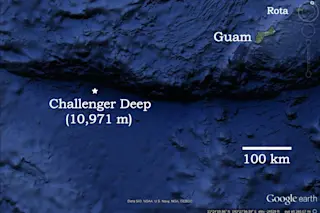If you’re looking for some peace and quiet, you certainly won’t find it at the bottom of the ocean.
Scientists from the NOAA have released audio recordings taken from the Mariana Trench, the deepest part of the ocean. Even here, sounds from humans, animals and even the earth itself eerily echo in the dark.
Researchers sunk a specialized probe, called a hydrophone, almost 36,000 feet into the Challenger Deep at the Mariana Trench in an effort to establish a baseline for oceanic noise. They were expecting to capture nothing more than a vast, echoing silence, given the extreme remoteness of their testing site. Instead, over the course of 23 days, they were able to capture whale calls, ship propellers, earthquakes, and even the sound of a Category 4 typhoon passing by overhead. In the recording below, you can hear a baleen whale calling, followed by a magnitude 5 earthquake that ...














